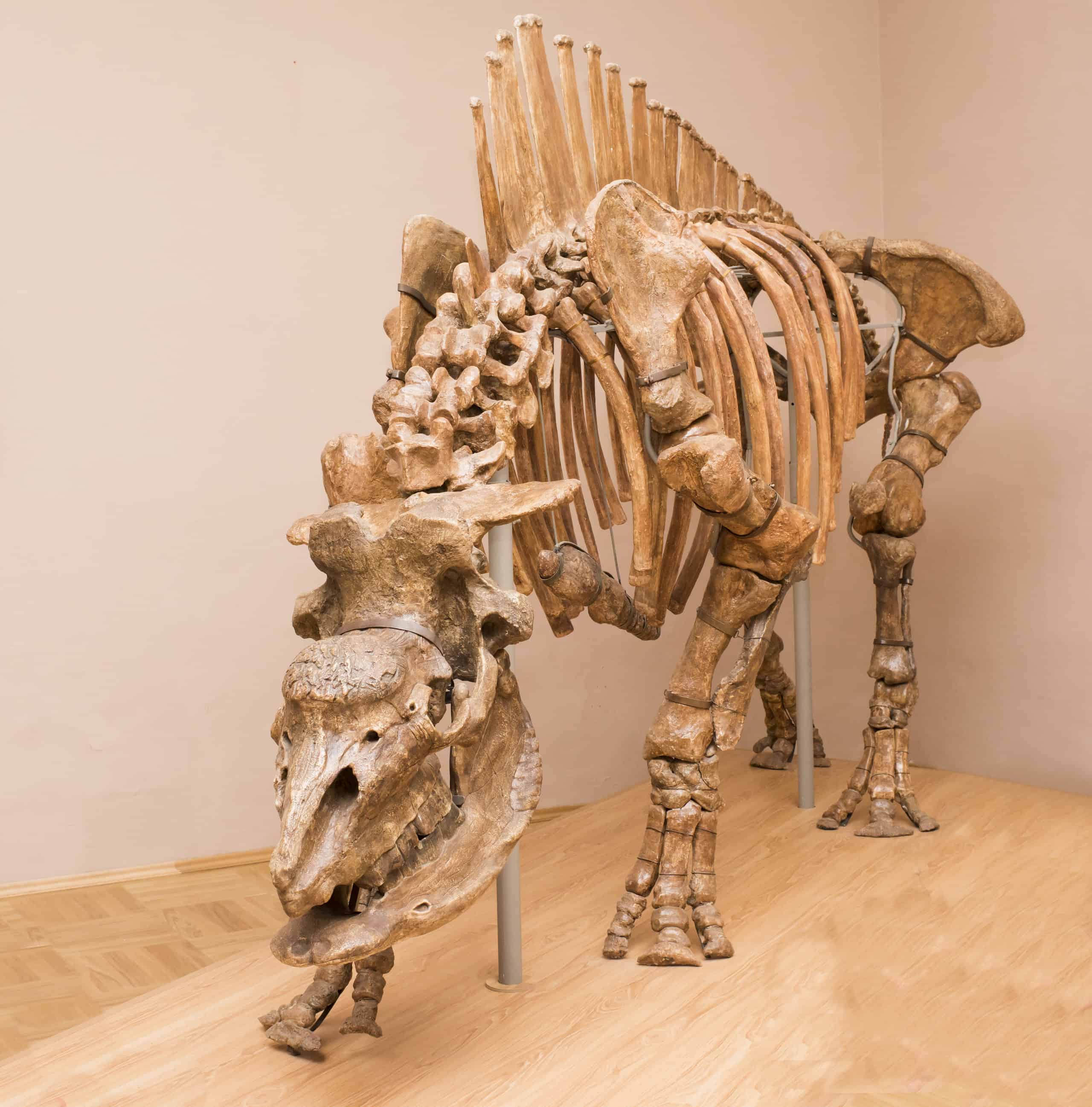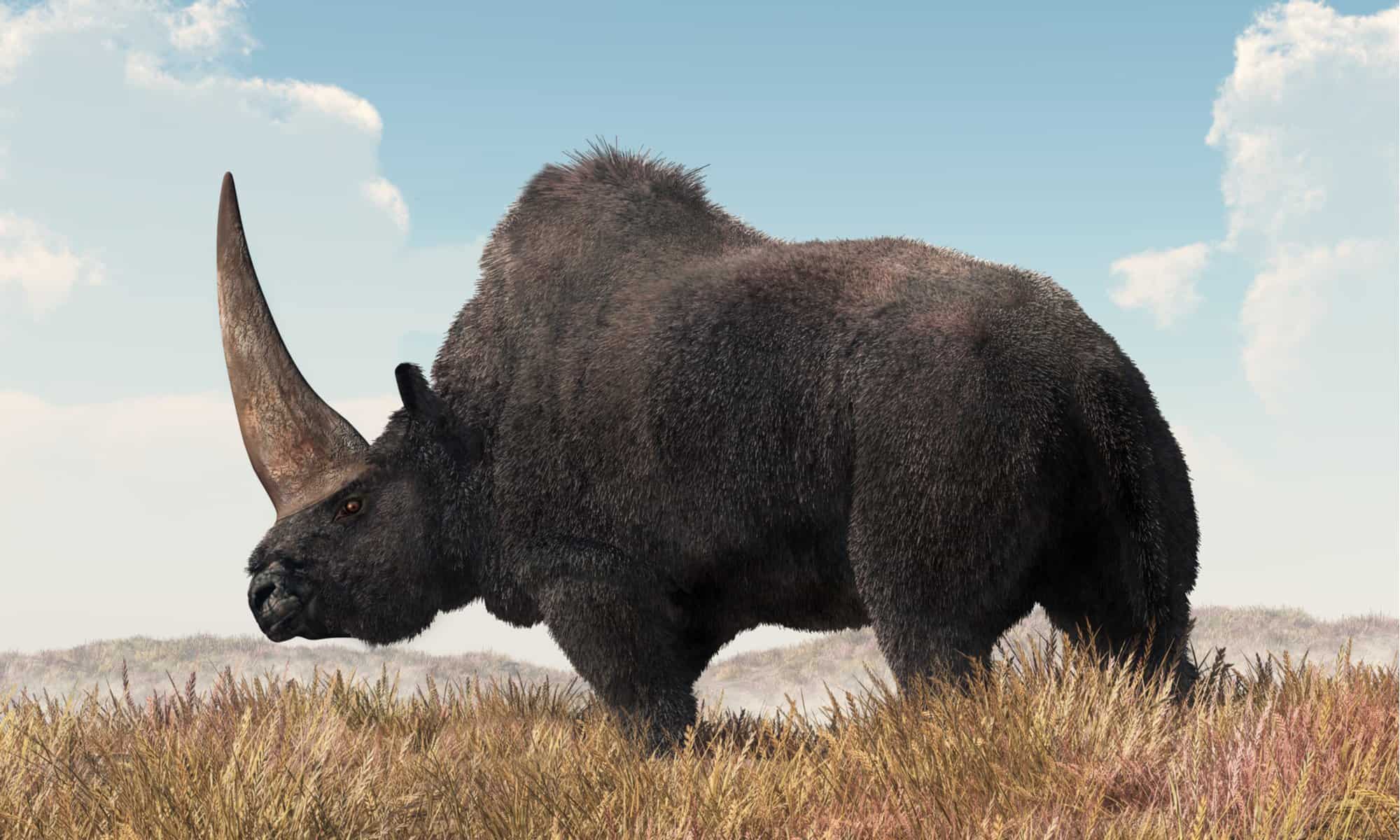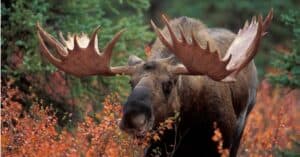Unicorns may sound like the stuff of fairytales, but something similar to these mythical creatures roamed the planet not so long ago.
The ancient species known as Elasmotherium wasn’t anything like a fairytale horse with a horn on its head. The Ice Age giant nicknamed the Siberian unicorn instead resembled a modern-day rhinoceros with a much larger mass and horn.
Even more incredible are the recent findings that indicate that Elasmotherium walked the Earth at the same time as Neanderthals and early humans. So what exactly is the ancient creature known as the Siberian unicorn? And how did it become extinct forever?

Elasmotherium was a horned rhinoceros mammal that lived in Russia, Ukraine, and Moldova during the Miocene and Pleistocene Periods.
©Catmando/Shutterstock.com
The Elasmotherium: Meet the Ancient Giant Known as the “Siberian Unicorn”
During the Ice Age, enormous and fascinating creatures roamed the planet. This period of time began 2.4 million years ago and lasted until 11,500 years ago. It was characterized by the earth’s climate fluctuating between very cold periods where giant glaciers covered the earth and warm periods where the glaciers melted.
The latter half of the Ice Age is known as the Pleistocene epoch. According to encyclopedia.com, during this time new and unique large mammals emerged due to the slow pulsation of continental glaciers. Some of these creatures included woolly mammoths and sabor-toothed cats.
Another was Elasmotherium, the “Siberian unicorn.” This extinct species of large rhinoceros made their home in Eurasia during the Late Miocene and Late Pleistocene eras. Recent evidence suggests that these creatures went extinct around 39,000 years ago.
Physical Characteristics: Describing the Appearance and Adaptations of the Elasmotherium
Despite their unicorn nickname, Elasmotherium’s bodies resembled that of a modern-day rhino rather than a horse, though they weighed around twice as much. In fact, Smithsonian Magazine states that these creatures tipped the scales at around 3.5 tons.
Siberian unicorns measured around 4.5 meters (15 feet) in length and 2.5 meters (8ft. 2 inches) tall at the shoulder. Some interpretations depict the Siberian unicorn as having shaggy hair, similar to that of a woolly mammoth. Others believe that Elasmotherium had mostly bare bodies like that of the modern rhino.
Speed
While Siberian unicorns may have been hefty, evidence also suggests that they had relatively slender limbs and were adept runners. Their longer legs gave them the ability to gallop with a gate like that of a horse.
However, due to their weight, Siberian unicorns probably couldn’t run as fast as modern-day rhinos, which can reach top speeds of 25–28 mph. Elosmotherium was also an ungulate (hoofed animal) with three functional toes and a vestigial digit.

The Elasmotherium is famous for its monstrous, 3-meter horn.
©Elenarts/Shutterstock.com
Horn
A circular dome on Elasmotherium’s forehead indicates that it had a large horn, thought to be around three meters or roughly 10 feet long. The creature’s horn was made of keratin, which doesn’t fossilize the same way as bone.
For this reason, researchers have studied the dome on the remains of the Siberian unicorn, as well as the creature’s spinal structure to determine the size of the horn.
It is believed that Elasmotherium used its horn for purposes similar to that of the modern-day rhino. A rhino’s horn can be used to intimidate and defend against predators or impress a potential mate. Rhinos also sometimes use their horn to dig for water or plant tubers.
Teeth
Fossils from the teeth of Siberian unicorns tell us a lot about these creature’s diet. They had molars and premolars for chewing and lacked incisors and canines similar to that of the modern-day rhino and other herbivores.
This makes perfect sense for creatures whose diet was made up almost exclusively of tough dry grass. Elasmotherium is also believed to have had a prehensile lip, allowing it to grip vegetation and strip it for food.
Habitat and Extinction: Exploring the Environment and Demise of the “Siberian Unicorn”
Fossil evidence suggests that Siberian unicorns made their homes in Eurasia, in the modern-day countries of Kazakhstan, western and central Russia, Ukraine, Azerbaijan, and Uzbekistan.
Believe it or not, early humans and Siberian unicorns lived at the same time for a while. The earliest humans emerged in Africa some 6-2 million years ago.
Some of these humans remained on the continent and were largely unaffected by the Ice Age. Others began to migrate to other parts of the world, where they might have come in contact with Elasmotherium.

Hundreds of Elasmotherium fossils were discovered throughout Asia and Eastern Europe.
©Aleks49/Shutterstock.com
Cause of Extinction
Given human’s tendency to destroy animals’ natural habitats and hunt them to the point of extinction, it might seem likely that we are to blame for the loss of the Siberian Unicorn. However, that’s actually not the case. Nor were predators of any kind the cause of Elasmotherium’s extinction.
According to BBC News, Elasmotherium actually died out due to their very specific diet, as well as changes in climate. These creatures almost exclusively fed on tough, dry grasses.
Professor Adrian Lister of the Natural History Museum, London, called them a “kind of prehistoric lawnmower” while speaking to the BBC. As the earth warmed thousands of years ago, grasslands began to shrink, eliminating the Siberian unicorn’s main source of food.
“Any change in their environment is a danger for them,” Lister added. “And, of course, what we’ve also learned from the fossil record is that once a species is gone, that’s it, it’s gone for good.”
Scientific Discoveries: Fossil Evidence and Insights into the Elasmotherium’s Existence
Although the Siberian unicorn lived thousands of years ago, researchers are still making new discoveries about these fascinating creatures. Some of the most recent findings change when Elasmotherium was thought to have gone extinct and show their close relation to the modern rhino.

Siberian unicorns may have gone extinct around the same time as woolly mammoths.
©iStock.com/Aunt_Spray
First Elasmotherium Fossils
Elasmotherium was first named in 1808. Gotthelf Fischer von Waldheim, the Dirécteur Perpétuel of the Natural History Museum at Moscow University studied a lower jaw bone donated to the museum by Princess Ekaterina Dashkova, Ancient Origins writes.
In 1877, German naturalist Johann Friedrich von Brandt determined that the Siberian unicorn belonged to the subfamily Elasmotheriinae.
Researchers continued to study the fossil and over the years more and more specimens have emerged. Most fossils consist of cranial bone fragments and teeth. However, nearly complete skulls have been found across Eurasia, such as the preserved skull found in Kazakhstan in 2016.
Extinction Date
Humans are still discovering more and more information about the Siberian unicorn. Until recently, it was thought that this Ice Age giant died out between 100,000 and 200,000 years ago.
In a study published in the journal, Nature, Ecology, & Evolution, scientists from the Netherlands, Russia, and the United Kingdom examined fossils from 23 Siberian unicorns. Their findings determined that this species was still alive 39,000 years ago and possibly even more recently according to Smithsonian Magazine.
This suggests that Siberian unicorns lived at the same time as early modern humans. They may have also died out during the “Quaternary extinction event,” during which other Ice Age giants such as woolly mammoths and Irish elk met their end.
DNA Extraction
Researchers in that same study analyzed DNA extracted from fossilized Elasmotherium specimens. Their study found that the ancestors of modern rhinos split from Elasmotherium 43 million years ago.
According to Smithsonian Magazine, study co-author Kieren Mitchell, a post-doctoral research associate at the University of Adelaide, stated: “That makes the Siberian unicorn and the African white rhino even more distant cousins than humans are to monkeys.”
Thank you for reading! Have some feedback for us? Contact the AZ Animals editorial team.








